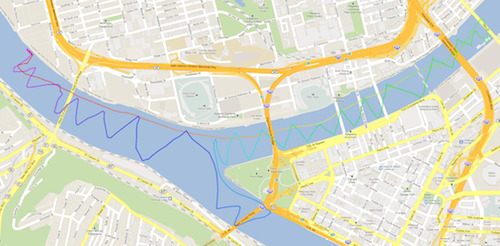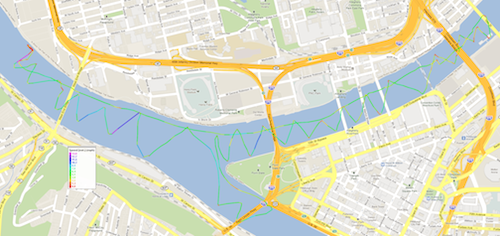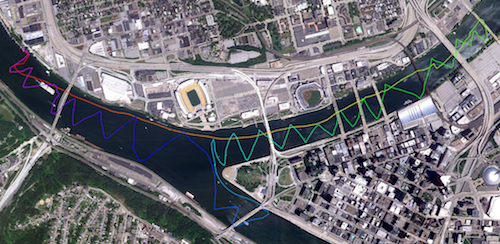The Big Boat on the Allegheny
August 7, 2011
Last week, we set up our big Hobie Getaway at the Newport Marina, ready and waiting in the water for an easy launch. This Sunday afternoon was to be our next sail. We started with a total of six potential sailors, including me. But late night partying, aversion to hot weather and long drives "south" took their toll. There was only Eve and me left. And Eve would, truth be told, prefer to be out cycling. But she came to keep me company and help work the sails.
The weather conditions looked pretty much perfect. The forecast called for 7-8 WSW winds forecast. They ought to send us flying up the Allegheny, which became the plan. We didn't like the mid 80s temperatures, but this summer that sort of heat has been hard to escape. We brought plenty of water.
As usual, I'd been keeping an eye on the currents. Just before setting off, I noticed that the currents on the Ohio were showing a rapid rise. By the time we returned and this graph was plotted, they had risen to 17,300 cubic feet per second.
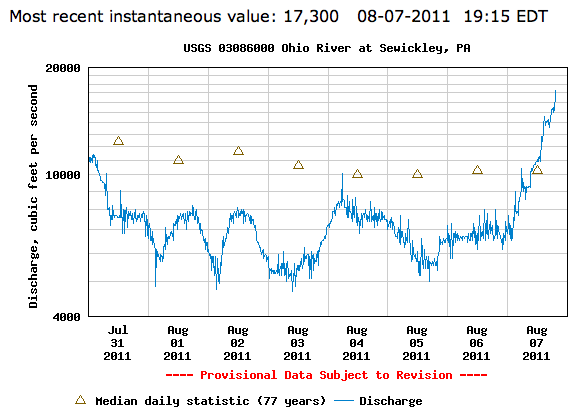
The reason for the rise, I quickly ascertained, was a sudden rise in river flow on the Mon:
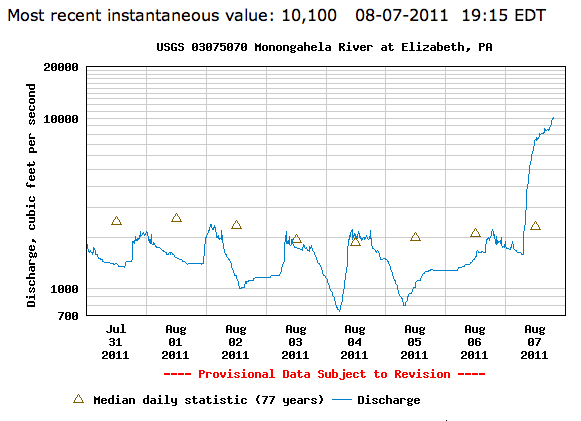
The flows on the Allegheny and Yough were low.
By the time Eve and I had cycled over to the marina, I was sure that we needn't worry about this extra flow. The winds were strong, kicking up a few whitecaps here and there. That meant they were gusting up to 15 mph. With that sort of wind and the extra speed of the big Getaway, these currents would not even be noticeable, I expected. And that was right.
The winds were blows strongly and steadily upstream towards the point on the Ohio river. That isn't exactly what I expected from the forecast WSW winds. The actual conditions, as reported later, were 9 mph winds from the West and WNW. (To read the linked table, note that we sailed roughly from 4:15 to 6:10pm.)
The winds then on the Ohio were likely stronger than 9 mph and gave us a real headache in launching the Getaway. We had it docked on the inside of a long, floating dock, running parallel to the shore:
We needed to maneuver it along the channel, past the end of the dock and around a big, rusty steel pier to which the dock was tied. With the wind turning the boat in unwanted ways, that proved to be a devil of a job. The goal was to get the boat at the end of the dock with the bows pointing into the wind. Only with the bow in the wind can we slide the mainsail easily in its track up the masts.
After much fumbling, pulling and throwing of lines, we eventually got there. Here's Eve in the boat at the end of the dock just before we hoisted the sail. She's smiling, but it had been tough work getting it there.
We discovered on our return that the shore line is sufficiently shallow and rocky for it to be quite easy for me to pull the boat to the shore and walk it along the to the end of the dock. Next time it will be much easier! (This seems to be the way of sailing. You will make every mistake possible. The goal is to learn to make every mistake just once!)
Once we were in the water, we had strong winds at our backs. We made an easy and fast run along the Ohio River, past the Point and up the Allegheny. I hadn't planned to sail very far up the Allegheny. But the winds were so steady that it seemed worth going farther. "Let's see how far we get in 30 minutes," I said. We started up the river at 4:15pm. By 4:45pm, we were passing under the span of the 16th Street Bridge and ready to turn. We'd come over two miles.
Here are the gps tracks:
These tracks show rather well how WNW winds are funneled over the rivers. The zigzags are the tracks of the boat sailing back into the wind. Where they are symmetric, we are sailing directly into a steady wind, blowing roughly from the West (left). We have those symmetric tracks on the Ohio, the Mon and the early part of the Allegheny to just past the Convention Center. Just after the Veteran's Bridge, the winds slowed and were less reliable. That is reflected is less regular zigzags.
Two points to note about the wind:
First, it shows that higher up the Allegheny, the WNW winds are now obstructed from blowing along the river course. This is just what we'd expect since the river course is slowly curving away from the direction of the winds.
Second, the wind is divided at the Point and blows along each of the Allegheny and Mon's courses.
We turned just past the 16th Street Bridge to head back. At that moment, we heard five horn blasts. That, as I already knew, is the signal for distress, such as danger of imminent collision. Looking up the river, in the distance, we could see a barge making its way towards us. The barge was so far away that a distress signal seemed an overreaction. But then perhaps the barge skipper had seen the very big sail easily and didn't realize just how fast we were moving. At that moment, we were making 5 mph. With that sort of mobility, the barge would have trouble running us down if it tried to make a sport of it.
This seemed to be a finer point. I didn't want to get into an argument with a barge. Directly ahead of us close to shore was a large rust pier in the water. I could sail straight up to it. Then we could moor to a large iron ring hanging from it and have our bows pointing into the wind. That is the most comfortable way for a sailboat to stop. So that is what we did.
It gave us a chance to drink some water and nibble on the nuts and dried fruit. I kept assuring Eve that the barge moves quickly so it arrive would soon. Still, we seemed to wait a while before its foaming bows poked under the bridge:
Then the enormity of the barge slid into view.
I waved cheerly at the captain, but got no response. I'm guessing this barge captain had little patience for pleasure boaters on his river. A few minutes later, we heard the five blasts again, just when we guessed the barge would have arrived at a cluster of boats and kayaks lower down the Allegheny.
My habit has been to take photos while sailing. That means that I am in none of the photos, unless I take special troubles to aim the camera at myself. What was different about this sail was there was someone volunteering to take photos of me. So I handed the camera to Eve and this is what happened:
... and they should last a lifetime.
Eve was keen to head for home as we neared the Point. However she let me take a short turn up the Mon. I explained that I wanted to test the winds there, using the gps tracks as a convenient probe. By 6:10, we were back at the dock. All in all, we had covered a lot of river in a short time, at least by the standards I was used to. The big Getaway is that much faster than the little Bravo. The speed plot shows sustained speeds of 14 mph in two places, something the Bravo cannot do.
Just as we were on our final approach, aiming for the narrow mouth in the channel behind the dock, a sudden fierce gust of wind sent us hurtling over the water with one hull up in the air. By the time I'd released the mainsheet we were sailing rapidly towards a moored boat. I turned the tiller abruptly and just managed to carve a little loop around the end of dock. I tried to turn up into the channel. That put us head on into the wind. We stalled and drifted onto the shore. We'd had a few final electric moments, but now our sail was over. Looking down into the water, I could see how shallow it was, so we finally decided jus to walk the boat up to its mooring.
For the last few years of sailing, as I made my way to the marina, I had gotten used to cycling past the Casino while it was under construction and then the completed building. The Casino fronts onto the river and has a rather appealing restaurant where you can sit and eat, looking out over the river.
Almost every time I cycle past I say to myself, "one day Eve and I will come here after sailing for dinner." That day is today.
It had been hot on the river and it is hard work sailing. We'd had a good work out. So a cool drink was quite welcome.
John D. Norton
Back to main
